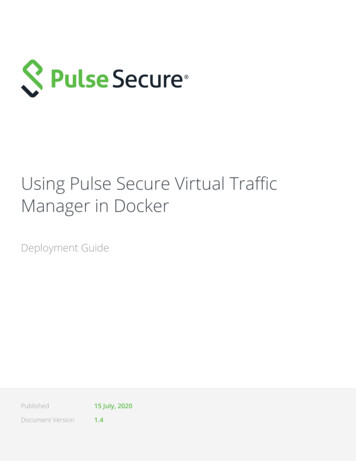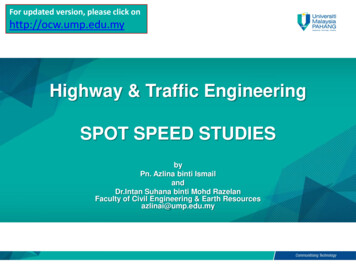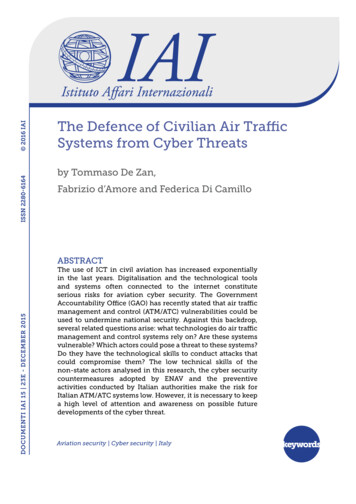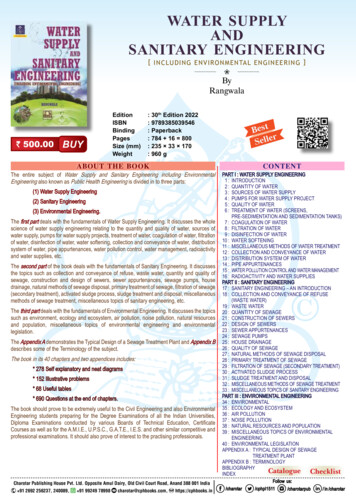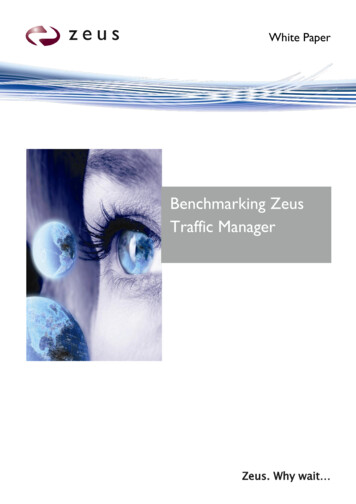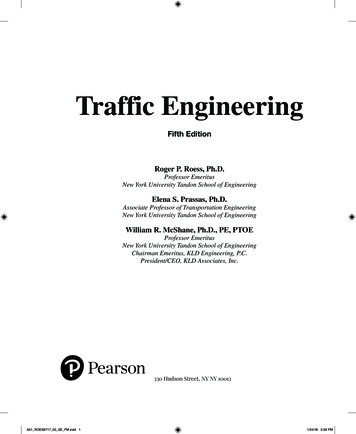
Transcription
Traffic EngineeringFifth EditionRoger P. Roess, Ph.D.Professor EmeritusNew York University Tandon School of EngineeringElena S. Prassas, Ph.D.Associate Professor of Transportation EngineeringNew York University Tandon School of EngineeringWilliam R. McShane, Ph.D., PE, PTOEProfessor EmeritusNew York University Tandon School of EngineeringChairman Emeritus, KLD Engineering, P.C.President/CEO, KLD Associates, Inc.330 Hudson Street, NY NY 10013A01 ROES9717 05 SE FM.indd 11/24/18 3:39 PM
Senior Vice President Courseware Portfolio Management:Marcia J. HortonDirector, Portfolio Management: Engineering, ComputerScience & Global Editions: Julian PartridgeExecutive Portfolio Manager: Holly StarkPortfolio Management Assistant: Amanda PerfitProduct Marketing Manager: Yvonne VannattaField Marketing Manager: Demetrius HallMarketing Assistant: Jon BryantManaging Content Producer: Scott DisannoContent Producer: Amanda BrandsProject Manager: Louise CapulliInventory Manager: Bruce BoundyRights and Permissions Manager: Ben FerriniManufacturing Buyer, Higher Ed, Lake SideCommunications, Inc. (LSC): Maura Zaldivar-GarciaCover Designer: Black Horse DesignsCover Illustration/Photo(s): JG Photography/Alamy Stock PhotoFull-Service Project Management: Integra Software ServicesPvt. Ltd./Ashwina RagunathPrinter/Binder: LSC Communications, Inc.Credits and acknowledgments borrowed from other sources and reproduced, with permission, in this textbook appear on appropriatepage within text.Copyright 2019, 2011, 2004, by Pearson Education, Inc., Hoboken, NJ 07030. Manufactured in the United States of America.This publication is protected by copyright and permissions should be obtained from the publisher prior to any prohibited reproduction,storage in a retrieval system, or transmission in any form or by any means, electronic, mechanical, photocopying, recording, or otherwise. For information regarding permissions, request forms and the appropriate contacts within the Pearson Education GlobalRights & Permissions department, please visit www.pearsoned.com/permissions/.Many of the designations by manufacturers and seller to distinguish their products are claimed as trademarks. Where those designations appear in this book, and the publisher was aware of a trademark claim, the designations have been printed in initial capsor all caps.The author and publisher of this book have used their best efforts in preparing this book. These efforts include the development,research, and testing of theories and programs to determine their effectiveness. The author and publisher make no warranty of anykind, expressed or implied, with regard to these programs or the documentation contained in this book. The author and publisher shallnot be liable in any event for incidental or consequential damages with, or arising out of, the furnishing, performance, or use of theseprograms.Library of Congress Cataloging-in-Publication DataNames: Roess, Roger P., author. Prassas, Elena S., author. McShane,William R., author.Title: Traffic engineering/Roger P. Roess, Elena S. Prassas, William R.McShane.Description: Fifth edition. Hoboken, NJ : Pearson Education, 2019. Includesbibliographical references.Identifiers: LCCN 2017054076 ISBN 9780134599717 ISBN 0134599713Subjects: LCSH: Traffic engineering—United States.Classification: LCC HE355 .M43 2018 DDC 388.3/120973—dc23 LC record available at https://lccn.loc.gov/2017054076118ISBN-10: 0-13-459971-3ISBN-13: 978-0-13-459971-7A01 ROES9717 05 SE FM.indd 21/24/18 3:39 PM
ContentsPrefaceix3.33.43.5Vehicle Characteristics 37Roadway Characteristics 47Traffic Control Systems andCharacteristics 513.6Closing Comments 51References 51Problems 52Part I Basic Concepts 2Traffic Engineering as a Profession 2Transportation Systems and TheirFunction 51.3History of U.S. Highway Legislation 91.4Elements of Traffic Engineering 131.5Modern Problems for the Traffic Engineer 141.6Standard References for the TrafficEngineer 151.7Metric versus U.S. Units 161.8Closing Comments 16References 16244.1The Manual on Uniform Traffic ControlDevices 534.2Traffic Markings 574.3Traffic Signs 634.4Traffic Signals 754.5Special Types of Control 814.6Closing Comments 81References 82Problems 82Transportation Modesand Characteristics 172.12.2Classifying Transportation Modes 17The Transportation Infrastructureand Its Use 182.3Modal Attributes 192.4The Capacity of Transportation Modes 222.5Multimodal Focus 25References 25Problems 2635Traffic Stream Characteristics 835.15.25.3Types of Facilities 83Traffic Stream Parameters 84Relationships among Flow Rate, Speed,and Density 925.4A Brief History of Mathematical Modelsof Freeway Flow—Traffic Flow Theory 945.5Characteristics of Interrupted Flow 1005.6Closing Comments 100References 100Problems 100Road-User, Vehicle, and RoadwayCharacteristics 273.13.2Communicating with Drivers: TrafficControl Devices 53Dealing with Diversity 27Road Users and Their Characteristics 28iiiA01 ROES9717 05 SE FM.indd 31/24/18 3:39 PM
iv6CONTENTSThe Concepts of Demand,Volume, and Capacity 1026.16.2When Capacity Constrains Demand 102Relationships among Demand,Volume (or Rate of Flow),and Capacity 1036.3The Formation of Queues and Their Impacts 1076.4Bottlenecks, Hidden Bottlenecks, andDemand Starvation 1096.5Capacity versus Queue Discharge 1106.6Closing Comments 112Problems 1127Level of Service and the HighwayCapacity Manual: History and Fundamental Concepts 114Uninterrupted and InterruptedFlow Facilities 1157.2A Brief Chronology of theHighway Capacity Manual 1157.3The Concept of Capacity 1187.4The Concept of Level of Service 1197.5Service Volumes and ServiceFlow Rates 1237.6The v/c Ratio and Its Use in CapacityAnalysis 1247.7Closing Comments 125References 125Problems 125Part II Traffic Studies and Programs 13799.19.29.39.49.5Sources of Data 139The Connected Vehicle 144Applications of Traffic Data 144Types of Studies 145Manual Data Collection Methodologies 1469.6Semi-Automated Studies Using PneumaticRoad Tubes and Similar Devices 1509.7Permanent Detectors and Their Use 1519.8Closing Comments 152References 152Problems 152107.18An Overview 127ITS Standards 128ITS Systems Engineering Process 129ITS-Related Commercial Routing andDelivery 1318.5Sensing Traffic by Virtual and Other Detectors 1318.6Connected Vehicle Pilot Studies 1328.7Variable Pricing 1348.8Closing Comments 135References 135Problems 135A01 ROES9717 05 SE FM.indd 4Traffic Volume Studies and Characteristics 15510.1 Volume Characteristics 15510.2 Intersection Volume Studies 16310.3 Limited Network Volume Studies 16510.4 Statewide Counting Programs 17210.5 Specialized Counting Studies 17710.6 Closing Comments 184References 184Problems 18411Speed, Travel Time, and DelayStudies 18611.1 Introduction 18611.2 Spot Speed Studies 18711.3 Travel-Time Studies 20511.4 Intersection Delay Studies 21111.5 Closing Comments 216References 216Problems 216Intelligent TransportationSystems 1268.18.28.38.4Traffic Data Collectionand Reduction Methodologies 13812Highway Traffic Safety: ction 218Current and Emerging Priorities 220The Highway Safety Manual 227Historical Crash Data and Regressionto the Mean 238Effective Crash Countermeasures 238Approaches to Highway Safety 2401/24/18 3:39 PM
CONTENTSv16.316.416.5Controller and Other Standards 343Common Terminology 344Convention for Numbering Movementsand Phases 34616.6 Ring-and-Barrier Diagram 34716.7 Preferential Treatment 35016.8 ASCT System Objectives 35116.9 Sensors and Data Feeds 35116.10 Traffic Signal Display Hardware 35416.11 Traffic Signal Maintenance 35516.12 Closing Comments 356References 356Problems 35612.7Commonly Used Crash Statisticsand Analyses 24312.8 Site Analysis 24712.9 Closing Comments 250References 250Problems 25113Parking: Characteristics, Studies,Programs, and Design 25413.113.213.313.4Parking Demand 255Parking Studies and Characteristics 263Design Aspects of Parking Facilities 271Parking Programs, Policy, and Management 28213.5 Closing Comments 284References 284Problems 284141717.1Intersection Design Objectives andConsiderations 35817.2 A Basic Starting Point: Sizing theIntersection 35917.3 Intersection Channelization 36217.4 Special Situations at Intersections 36417.5 Closing Comments 373References 373Problems 373Traffic Impact Studies and Analyses 286Scope of This Chapter 287An Overview of the Process 287Tools, Methods, and Metrics 292Case Study 1: Driveway Location 293Case Study 2: Most Segmentsof a Traffic Impact Analysis 29614.6 Closing Comments 307References 307Problems 30814.114.214.314.414.518Terms and Definitions 374Discharge Headways, Saturation Flow,Lost Times, and Capacity 37718.3 The Critical-Lane and Time-Budget Concepts 38218.4 The Concept of Left-Turn (and RightTurn) Equivalency 38718.5 Delay as a Measure of Effectiveness 38918.6 Closing Comments 400References 400Problems 400The Hierarchy of Intersection Control 310Level I Control: Basic Rules of theRoad 31115.2 Level II Control: YIELD and STOP Control 31315.3 Level III Control: Traffic Control Signals 31715.4 Closing Comments 333References 333Problems 33315.116Traffic Signal Hardware 33816.116.2A01 ROES9717 05 SE FM.indd 5Functional Layouts at a Signalized Intersection 338Some History 340Principles of Intersection Signalization 37418.118.2Part III Interrupted Flow Facilities: Design,Control, and Level of Service 30915Fundamentals of IntersectionDesign and Layout 35819Fundamentals of Signal Timing andDesign: Pre-timed Signals t of a Signal Phase Plan 404Determining Vehicular Requirements forSignal Design and Timing 419Determining Pedestrian SignalRequirements 4261/24/18 3:39 PM
viCONTENTSPart II: Analysis of ActuatedSignals 536Part III: Calibration Issues 53622.6 Measuring Prevailing Saturation FlowRates 53722.7 Measuring Base Saturation FlowRates 53722.8 Measuring Start-Up Lost Time 53722.9 Calibrating Adjustment Factors 53922.10 Normalizing Signalized Intersection Analysis 541Part IV: Closing Comments 542References 542Problems 54219.5 Compound Signal Phasing 42919.6 Sample Signal Timing Problems 430References 442Problems 44320 Fundamentals of Signal Timing andDesign: Actuated Signals 44720.120.220.3Types of Actuated Control 448Detectors and Detection 449Actuated Control Features andOperation 45020.4 Actuated Signal Timing and Design 45320.5 Sample Problems in Actuated Signal Design and Timing 458References 464Problems 4642123Signal Coordination for Arterials andNetworks 467A Key Requirement: A Common CycleLength 46721.2 The Time-Space Diagram 46721.3 Ideal Offsets 46921.4 Signal Progression on One-WayStreets 46921.5 Signal Progression for Two-Way Streetsand Networks 47521.6 Types of Progression 48121.7 Software for Signal Progression Design 48521.8 Coordination of Signals for OversaturatedNetworks 486References 495Problems 49523.123.2The TRB Circular 212 Methodology 545The 2016 HCM PlanningMethodology 54623.3 Closing Comments 556References 556Problems 55721.122Capacity and Level of Service Analysis:Signalized Intersections—The HCMMethod 499Part I: Analysis of Pre-timed SignalizedIntersections 50022.1 Fundamental Concepts 50022.2 Model Structure for Pre-timedSignals 50522.3 Computational Steps in the Model 50522.4 Interpreting the Results of SignalizedIntersection Analysis 52822.5 Methodological Complexities 529A01 ROES9717 05 SE FM.indd 6Planning-Level Analysis of SignalizedIntersections 54524Urban Streets and Arterials: CompleteStreets and Level of Service 55924.124.2Designing Urban Streets 560Level of Service Analysis of a MultimodalStreet Segment 56324.3 Facility Level of Service Analysis 57024.4 Closing Comments 570References 570Problems 57125Unsignalized Intersectionsand Roundabouts 572Part I: Two Way Stop-Controlled Intersections 57325.1 TWSC Intersection Operation:A Fundamental ModelingApproach 57325.2 Computational Steps in TWSCIntersection Analysis 57425.3 Interpreting Results 584Part II: All-Way STOP-ControlledIntersections 58925.4 Computational Steps 59125.5 Comment 5981/24/18 3:39 PM
CONTENTSviiPart III: Roundabouts 60225.6 Types of Roundabouts andGeneral Characteristics 60325.7 Signing and Marking forRoundabouts 60325.8 Capacity and Level of ServiceAnalysis of Roundabouts 60825.9 Closing Comments 615References 615Problems 61626 Interchanges and Alternative Intersections 61828.6Applications of Base Curves to Capacityand LOS Analysis of Freewaysand Multilane Highways 68728.7 The Heavy Vehicle AdjustmentFactor and Related Issues 68928.8 Sample Problems 69428.9 Closing Comments 700References 700Problems 7012926.1 Interchanges 61926.2 Alternative Intersections 62526.3 Level of Service Analysis 63026.4 Closing Comments 638References 639Problems 63929.1Level of Service Criteria for Weaving Segments 70429.2 Converting Demand Volumes to FlowRates in pc/h 70529.3 A Brief History of the Development ofWeaving Segment Methodologies 70529.4 Component Flows in a WeavingArea 70629.5 Critical Geometric Variables Describing aWeaving Segment 70729.6 Computational Procedures for WeavingArea Analysis 71129.7 Sample Problems in Weaving SegmentAnalysis 720References 725Problems 726Part IV Uninterrupted Flow Facilities: Design, Control, and Level of Service 64327An Overview of Geometric Designof Roadways 644Introduction to Highway Design Elements 64427.2 Horizontal Alignment of Highways 64627.3 Vertical Alignment of Highways 65927.4 Cross-Sectional Elements of Highways 66527.5 Closing Comments 669References 669Problems 66927.128Capacity and Level of ServiceAnalysis: Basic Freeway andMultilane Highway Segments 67128.128.228.328.428.5A01 ROES9717 05 SE FM.indd 7Facility Types Included 671Segment Types on Freeways and SomeMultilane Highways 672Generic Speed-Flow Characteristicson Freeways and MultilaneHighways 672Levels of Service for Freewaysand Multilane Highways 674Base Speed-Flow Curves 676Capacity and Level of Service Analysis:Weaving Segments on Freewaysand Multilane Highways 70330Capacity and Level of Service Analysis: Merge and Diverge Segments on Freeways and Multilane Highways 72830.130.230.3Level-of-Service Criteria 729Converting Demand Volumes 729Fundamental Variables Involved in Mergeand Diverge Segment Analysis 73030.4 Computational Procedures for Merge andDiverge Segments 73130.5 Special Applications in Merge and DivergeAnalysis 74130.6 Closing Comments 74530.7 Sample Problems in Merging and Diverging Analysis 745References 751Problems 7511/24/18 3:39 PM
viii31CONTENTSOperation and Analysis of Freewaysand Highways 75331.131.231.3Traffic Markings on Freeways and RuralHighways 753Signing for Freeways and Rural Highways 758Establishing and Posting of Speed Limitson Rural Roads 771A01 ROES9717 05 SE FM.indd 831.431.5Managed Lanes on Freeways 772Active Transportation and Demand Management Strategies 77431.6 Analysis of Freeway Facilities 774References 776Problems 777Index 7781/24/18 3:39 PM
PrefaceThe transportation system is the nation’s lifeblood circulation system. Our complex system of roads and highways,railroads, airports and airlines, waterways, and urbantransit systems provides for the movement of people andgoods to and from the most remote outposts of the nation. It is the transportation network which allows for theconcentrated production of food, goods, energy, and other material in an economically optimal manner, knowingthat the systems needed to collect raw materials, and distribute final products throughout the nation are in place.Traffic engineering deals with several critical elements of the transportation system: our streets andhighways, and the transportation services they support.Because the transportation system is such a critical partof our infrastructure, the traffic engineer is involved in awide range of issues, often in a very public setting, andmust bring a broad range of skills to the table. Traffic engineers must have an appreciation for and understandingof planning, design, management, construction, operation, control, and system optimization. All of these functions involve traffic engineers at some level.This text focuses on the key engineering skills required to practice traffic engineering in a broad setting.This is the fifth edition of the textbook, and it includesthe latest standards and criteria of the Manual on UniformTraffic Control Devices (2009, as updated through May2012), the Policy on Geometric Design of Highways andStreets (2011), the Highway Capacity Manual (2016), theHighway Safety Manual (2010, with 2014 Supplement),and other critical documents. While this edition uses thelatest versions of basic references, students must be awarethat all of these are periodically updated, and (at somepoint), versions not available at this writing will becomeavailable, and should be used.The text is organized into four major functional parts:Part I – Basic Concepts and CharacteristicsPart II – Traffic Studies and ProgramsPart III – Interrupted Flow Facilities: Design, Control, and Level of ServicePart IV – Uninterrupted Flow Facilities: Design,Control, and Level of ServiceThe text is appropriate for an undergraduate surveycourse in traffic engineering, or for more detailed graduate (or undergraduate) courses focusing on specific aspects of the profession. A survey course might includeall of Part I, a selection of chapters from Part II, and afew chapters focusing on signal design and/or capacityand level of service analysis. Over the years, the authorshave used the text for graduate courses on Traffic Studiesand Characteristics, Traffic Control and Operations, andHighway Capacity and Level of Service Analysis. Specialcourses on highway traffic safety and geometric designhave also used this text.Some chapters, particularly Traffic Impact and Mitigation Studies, are organized around case studies. Theseshould only be used in a more advanced course with aninstructor who is familiar with the many tools referenced.What’s New in This EditionThis edition of the textbook adds a significant amount ofmaterial, including, but not limited to:1. More than 50% of the homework problems (andan available solutions manual) are new for mostchapters.ixA01 ROES9717 05 SE FM.indd 91/24/18 3:39 PM
xPREFACE2. New material on unsignalized intersections,roundabouts, alternative intersections, interchanges, operation and analysis of facilities,and more.3. Material on signalized intersections, signaldesign and timing, and signal hardware has been updated and extended.4. Material from the latest editions of key trafficengineering references is included, as notedpreviously.5. Links to a number of new Web sites which students and instructors will find valuable.There are some additional revisions. There is nooverview chapter on statistics; undergraduate engineering degrees now require coursework in statistics. We haveincluded supporting material on statistical analyses within the applications in which they are used. An overviewchapter can’t cover everything, and it should be expectedA01 ROES9717 05 SE FM.indd 10that modern engineering students have been exposed tothis material. The text still provides details on a numberof capacity and level of service applications. The 2016HCM, however, has over 3,000 pages of printed and electronic material, and many complicated analyses can onlybe presented in outline or overview form. There is material from the Highway Safety Manual, but complete analysis material is included for only one type of application.Again, there is simply too much material to include morethan an example of its procedures and applications.We hope that students and instructors will continue to find this text useful in learning about theprofession of traffic engineering, and about many of itskey components. As in the past, comments are alwayswelcome.Roger P. RoessElena S. PrassasWilliam R. McShane1/24/18 3:39 PM
1.1 Traffic Engineering as a Profession 2 1.2 Transportation Systems and Their Function 5 1.3 History of U.S. Highway Legislation 9 1.4 Elements of Traffic Engineering 13 1.5 Modern Problems for the Traffic Engineer 14 1.6 Standard References for the Traffic Engineer 15 1.7 Metric versus U.S. Units 16 1.8 Closing Comments 16



